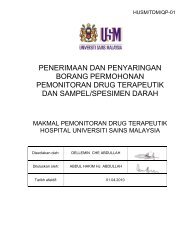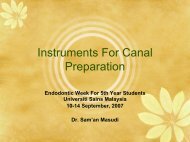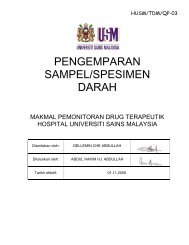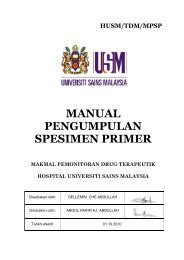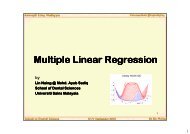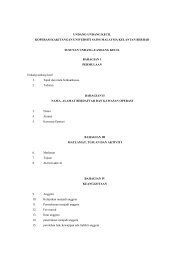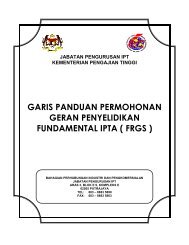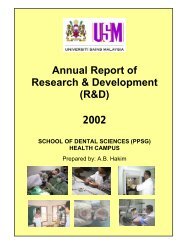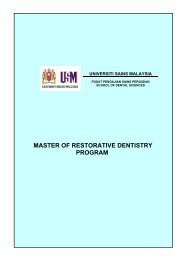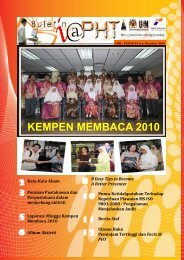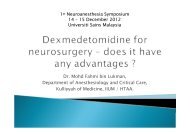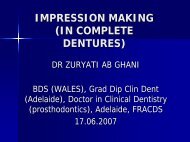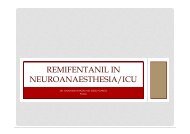Lecture slides anatomy of periodontium 2008
Lecture slides anatomy of periodontium 2008
Lecture slides anatomy of periodontium 2008
Create successful ePaper yourself
Turn your PDF publications into a flip-book with our unique Google optimized e-Paper software.
Anatomy <strong>of</strong> Periodontium<br />
Erry Mochamad Arief<br />
12 June 08<br />
12 June <strong>2008</strong> Year 3 Block Head & Neck<br />
1
Periodontium<br />
The tissue that support the teeth:<br />
• Gingiva<br />
• Periodontal ligament<br />
• Cementum<br />
• Alveolar process<br />
12 June <strong>2008</strong> Year 3 Block Head & Neck<br />
2
GINGIVA<br />
12 June <strong>2008</strong> Year 3 Block Head & Neck<br />
3
The Gingiva<br />
The oral mucosa consists <strong>of</strong> three zones:<br />
The gingiva and the covering <strong>of</strong> the hard<br />
palate, termed the masticatory mucosa<br />
The dorsum <strong>of</strong> the tongue, covered by<br />
specialized mucosa<br />
The oral mucous membrane lining the<br />
remainder <strong>of</strong> the oral cavity.<br />
The gingiva is the part <strong>of</strong> the oral mucosa that<br />
covers the alveolar processes <strong>of</strong> the jaws and<br />
surrounds the necks <strong>of</strong> the teeth.<br />
12 June <strong>2008</strong> Year 3 Block Head & Neck 4
Objectives<br />
Student should be able to<br />
<br />
<br />
<br />
describe the normal macroscopic features <strong>of</strong> the<br />
gingiva: marginal , attached, and interdental gingiva<br />
describe the normal microscopic features <strong>of</strong> the<br />
gingival epithelium, gingival connective tissue<br />
discuss the correlation <strong>of</strong> normal clinical and<br />
microscopic features<br />
12 June <strong>2008</strong> Year 3 Block Head & Neck<br />
5
A<br />
COL<br />
B<br />
C<br />
D<br />
E<br />
F<br />
G<br />
H<br />
I<br />
K<br />
L<br />
M<br />
PAPILLA<br />
JUNCTIONAL EPITHELIUM<br />
FREE GINGIVA<br />
ATTACHED GINGIVA<br />
MUCOGINGIVAL JUNCTION<br />
ALVEOLAR MUCOSA<br />
CEMENTUM<br />
PERIODONTAL LIGAMENT<br />
LINGUAL PLATE<br />
ALVEOLAR BONE/CRIBIFORM PLATE<br />
TRABECULAR/CANCELOUS BONE<br />
12 June <strong>2008</strong> Year 3 Block Head & Neck<br />
6
Gingiva<br />
Marginal/margin/free/unattached gingiva<br />
Fig.2<br />
12 June <strong>2008</strong> Year 3 Block Head & Neck<br />
7
Gingiva: Gingival Sulcus<br />
12 June <strong>2008</strong> Year 3 Block Fig.3 Head & Neck<br />
8
Gingival Sulcus<br />
<br />
<br />
<br />
<br />
Is the shallow crevice or space around the tooth<br />
bounded by the surface <strong>of</strong> the tooth on one side and the<br />
epithelium lining the free margin <strong>of</strong> the gingiva on the<br />
other side.<br />
It is V shaped, and it permits the entrance <strong>of</strong> a<br />
periodontal probe<br />
The clinical determination <strong>of</strong> the depth <strong>of</strong> the gingival<br />
sulcus is an important diagnostic parameter.<br />
The histologic depth <strong>of</strong> a sulcus does not need to be<br />
exactly equal to the depth <strong>of</strong> penetration <strong>of</strong> the probe.<br />
The so-called probing depth <strong>of</strong> a clinically normal<br />
gingival sulcus in humans is less than 3 mm<br />
12 June <strong>2008</strong> Year 3 Block Head & Neck 9
Gingiva<br />
Attached gingiva<br />
12 June <strong>2008</strong> Year 3 Block Head Fig.2 & Neck<br />
10
Gingiva: Interdental papilla<br />
Fig.4<br />
Fig.6<br />
Fig.5<br />
12 June <strong>2008</strong> Year 3 Block Head & Neck 11
12 June <strong>2008</strong> Year 3 Block Head & Neck<br />
12
Objectives<br />
<br />
<br />
<br />
<br />
Describe the normal macroscopic features <strong>of</strong> the<br />
marginal gingiva, attached gingiva, interdental<br />
gingiva<br />
Describe the normal microscopic features <strong>of</strong> the<br />
gingival epithelium, gingival connective tissue<br />
Discuss the correlation <strong>of</strong> normal clinical and<br />
microscopic features<br />
Integrate the knowledge <strong>of</strong> the histology <strong>of</strong> the<br />
gingival and dentogingival junctional tissues with the<br />
related pathology that may occur<br />
12 June <strong>2008</strong> Year 3 Block Head & Neck<br />
13
General Aspects <strong>of</strong> Gingival Epithelium Biology<br />
<br />
First, it was thought to provide only a physical barrier to<br />
infection and the underlying gingival attachment<br />
<br />
Epithelial cells play an active role in innate host defense<br />
by responding to bacteria in signaling further host<br />
reactions, and in integrating innate and acquired<br />
immune responses.<br />
<br />
For example, by increased proliferation, alteration <strong>of</strong><br />
cell-signaling events, changes in differentiation and cell<br />
death, and ultimately, alteration <strong>of</strong> tissue homeostasis.<br />
12 June <strong>2008</strong> Year 3 Block Head & Neck 14
Cell type <strong>of</strong> the gingival<br />
epithelium<br />
Keratinocytes<br />
Non keratinocytes cell<br />
• Melanocytes, these cells produce melanin,<br />
which is a pigment found in the skin, eyes,<br />
hair, and gingiva<br />
• Langerhans, Langerhans cells have an<br />
important role in the immune reaction as<br />
antigen-presenting cells for lymphocytes<br />
• Merkel cells, They have been identified as<br />
tactile perceptors<br />
12 June <strong>2008</strong> Year 3 Block Head & Neck<br />
15
Functions and Features <strong>of</strong> Gingival Epithelium<br />
<br />
<br />
<br />
<br />
Functions<br />
• Mechanical, chemical,<br />
water, and microbial barrier<br />
• Signaling functions<br />
Architectural Integrity<br />
• Cell-cell attachments<br />
• Basal lamina<br />
• Keratin cytoskeleton<br />
Major Cell Type<br />
• Keratinocyte<br />
Other Cell Types<br />
• Langerhans cells<br />
• Melanocytes, Merkel cells<br />
<br />
<br />
<br />
Constant Renewal<br />
• Replacement <strong>of</strong> damaged<br />
cells<br />
Cell-Cell Attachments<br />
• Desmosomes, adherens<br />
junctions<br />
• Tight junctions, gap<br />
junctions<br />
Cell-Basal Lamina<br />
• Synthesis <strong>of</strong> basal lamina<br />
components<br />
• Hemidesmosome<br />
Modified from Dale BA: Periodontol 2000 30:71, 2002.<br />
12 June <strong>2008</strong> Year 3 Block Head & Neck 16
Representative cells from the various layers <strong>of</strong> stratified squamous epithelium as seen by electron<br />
microscopy. (From Weinstock A. In Ham AW: Histology, 7th ed. Philadelphia, JB Lippincott, 1974.)<br />
12 June <strong>2008</strong> Year 3 Block Head & Neck<br />
17
Figure 4-11 Pigmented gingiva <strong>of</strong> dog showing melanocytes (M) in the basal epithelial layer and melanophores (C) in<br />
the connective tissue (Glucksman technique).<br />
12 June <strong>2008</strong> Year 3 Block Head & Neck<br />
18<br />
Downloaded from: Carranza's Clinical Periodontology (on 28 May <strong>2008</strong> 03:57 PM)<br />
© 2007 Elsevier
Figure 4-12 Human gingival epithelium, oral aspect. Immunoperoxidase technique showing Langerhans cells.<br />
Function: On infection <strong>of</strong> an area <strong>of</strong> skin, the local Langerhans' cells will take up and process microbial antigens to<br />
become fully-functional antigen-presenting cells<br />
12 June <strong>2008</strong> Year 3 Block Head & Neck<br />
19<br />
Downloaded from: Carranza's Clinical Periodontology (on 28 May <strong>2008</strong> 03:57 PM)<br />
© 2007 Elsevier
Figure 4-13 Normal human gingiva stained with the periodic acid-Schiff (PAS) histochemical method. The basement<br />
membrane (B) is seen between the epithelium (E) and the underlying connective tissue (C). In the epithelium,<br />
glycoprotein material occurs in cells and cell membranes <strong>of</strong> the superficial hornified (H) and underlying granular layers<br />
(G). The connective tissue presents a diffuse, amorphous ground substance and collagen fibers. The blood vessel walls<br />
stand out clearly in the papillary projections <strong>of</strong> the connective tissue (P).<br />
12 June <strong>2008</strong> Year 3 Block Head & Neck<br />
20<br />
Downloaded from: Carranza's Clinical Periodontology (on 28 May <strong>2008</strong> 03:57 PM)<br />
© 2007 Elsevier
Figure 4-14 Variations in gingival epithelium. A, Keratinized. B, Nonkeratinized. C, Parakeratinized. Horny layer (H),<br />
granular layer (G), prickle cell layer (P), basal cell layer (Ba), flattened surface cells (S), parakeratotic layer (Pk).<br />
12 June <strong>2008</strong> Year 3 Block Head & Neck<br />
21<br />
Downloaded from: Carranza's Clinical Periodontology (on 28 May <strong>2008</strong> 03:57 PM)<br />
© 2007 Elsevier
Gingival Epithelium<br />
Stratified squamous epithelium:<br />
• oral or outer epithelium<br />
• sulcular epithelium, and<br />
• junctional epithelium/epithelial<br />
attachment.<br />
12 June <strong>2008</strong> Year 3 Block Head & Neck<br />
22
1. GINGIVAL EPITHELIUM<br />
Bucco-lingual section<br />
<br />
<br />
<br />
<br />
<br />
CT, gingival connective<br />
tissue<br />
ES, enamel space<br />
JE, junctional epithelium<br />
OE, oral epithelium<br />
SE, sulcular epithelium<br />
12 June <strong>2008</strong> Year 3 Block Head & Neck<br />
23
Structural Characteristics <strong>of</strong><br />
the Gingival Epithelium: Oral<br />
or Outer Epithelium<br />
<br />
<br />
<br />
The oral or outer<br />
epithelium covers the crest<br />
and outer surface <strong>of</strong> the<br />
marginal gingiva and the<br />
surface <strong>of</strong> the attached<br />
gingiva.<br />
It is keratinized or<br />
parakeratinized. The<br />
prevalent surfaces however,<br />
is parakeratinized.<br />
Keratinization <strong>of</strong> the oral<br />
mucosa: palate (most<br />
keratinized), gingiva,<br />
tongue, and cheek (least<br />
keratinized)."<br />
12 June <strong>2008</strong> Year 3 Block Head & Neck<br />
24
Oral epithelium <strong>of</strong> the gingiva<br />
<br />
<br />
<br />
<br />
<br />
SC, stratum corneum (cornified<br />
layer)<br />
SG, stratum granulosum<br />
(granular layer)<br />
SS, stratum spinosum (spinous<br />
layer)<br />
SB, stratum basale (basal layer)<br />
CT, connective tissue<br />
12 June <strong>2008</strong> Year 3 Block Head & Neck<br />
25
Sulcular Epithelium<br />
<br />
<br />
The sulcular epithelium lines the<br />
gingival sulcus . It is a thin,<br />
nonkeratinized, stratified squamous<br />
epithelium without rete pegs and<br />
extends from the coronal limit <strong>of</strong> the<br />
junctional epithelium to the crest <strong>of</strong><br />
the gingival margin .<br />
The sulcular epithelium is extremely<br />
important, because it may act as a<br />
semipermeable membrane through<br />
which injurious bacterial products<br />
pass into the gingiva and through<br />
which tissue fluid from the gingiva<br />
seeps into the sulcus<br />
12 June <strong>2008</strong> Year 3 Block Head & Neck<br />
26
Junctional Epithelium (JE)<br />
<br />
<br />
<br />
<br />
<br />
Stratified squamous<br />
nonkeratinizing epithelium.<br />
3-4 layers thick in early life,<br />
but with age to 10-20.<br />
The length <strong>of</strong> the JE ranges<br />
from 0.25 to 1.35 mm<br />
PMN are found routinely in<br />
the JE<br />
More permeable than Sulcular<br />
epithelium<br />
12 June <strong>2008</strong> Year 3 Block Head & Neck<br />
27
Junctional epithelium<br />
Junctional epithelium<br />
CT, connective tissue<br />
ES, enamel space<br />
JE, junctional epithelium<br />
12 June <strong>2008</strong> Year 3 Block Head & Neck<br />
28
Junctional epithelium<br />
Inflamed junctional<br />
epithelium<br />
ES, enamel space<br />
PMN, polymorphonuclear<br />
leucocytes<br />
12 June <strong>2008</strong> Year 3 Block Head & Neck<br />
29
Junctional epithelium<br />
Diagram <strong>of</strong> junctional epithelium<br />
Arrows indicate path taken by<br />
cells and fluids between the<br />
sulcus and the gingival<br />
connective tissue<br />
CT, connective tissue<br />
JE, junctional epithelium<br />
OE, oral epithelium<br />
S, gingival sulcus<br />
SE, sulcular epithelium<br />
12 June <strong>2008</strong> Year 3 Block Head & Neck<br />
30
Renewal <strong>of</strong> gingival epithelium<br />
<br />
<br />
Daughter cells (B) migrate toward the sulcus. If a JE cell comes<br />
into contact with the tooth surface, it will attach to it<br />
Dentogingival collagen fiber<br />
12 June <strong>2008</strong> Year 3 Block Head & Neck<br />
31
Figure 4-18 Junctional epithelium on an erupting tooth. The junctional epithelium (JE) is formed by the joining <strong>of</strong> the oral epithelium<br />
(OE) and the reduced enamel epithelium (REE). AC, Afibrillar cementum, sometimes formed on enamel after degeneration <strong>of</strong> the<br />
REE. The arrows indicate the coronal movement <strong>of</strong> the regenerating epithelial cells, which multiply more rapidly in the JE than in<br />
the OE. E, Enamel; C, root cementum. A similar cell turnover pattern exists in the fully erupted tooth. (Modified from Listgarten MA:<br />
J Can Dent Assoc 36:70, 1970.)<br />
12 June <strong>2008</strong> Year 3 Block Head & Neck<br />
32<br />
Downloaded from: Carranza's Clinical Periodontology (on 28 May <strong>2008</strong> 03:57 PM)<br />
© 2007 Elsevier
Junctional epithelium<br />
<br />
<br />
<br />
The attachment <strong>of</strong> the junctional epithelium to the tooth is<br />
reinforced by the gingival fibers. For this reason, both are<br />
considered a functional unit, dentogingival unit.<br />
Their functions:<br />
• junctional epithelium is firmly attached to the tooth surface, forming an<br />
epithelial barrier against plaque bacteria.<br />
• it allows access <strong>of</strong> gingival fluid, inflammatory cells, and components <strong>of</strong> the<br />
immunologic host defense to the gingival margin.<br />
• junctional epithelial cells exhibit rapid turnover, which contributes to the<br />
host-parasite equilibrium and rapid repair <strong>of</strong> damaged tissue.<br />
Turnover times for different areas <strong>of</strong> the oral epithelium in<br />
experimental animals:<br />
• palate, tongue, and cheek, 5 to 6 days;<br />
• gingiva, 10 to 12 days,<br />
• junctional epithelium, 1 to 6 days<br />
12 June <strong>2008</strong> Year 3 Block Head & Neck 33
Gingival Fluid (Sulcular Fluid)<br />
<br />
<br />
<br />
<br />
<br />
<br />
It can be represented as either a transudate or an exudate<br />
It is potential use as a diagnostic or prognostic biomarker <strong>of</strong> the<br />
biologic state <strong>of</strong> the <strong>periodontium</strong> in health and disease.<br />
It is contains components <strong>of</strong> connective tissue, epithelium,<br />
inflammatory cells, serum, and microbial flora inhabiting the gingival<br />
margin or the sulcus (pocket).<br />
In the healthy sulcus the amount <strong>of</strong> the gingival fluid is very small.<br />
During inflammation, however, the gingival fluid flow increases<br />
The main route <strong>of</strong> the gingival fluid diffusion is through the basement<br />
membrane, through the relatively wide intracellular spaces <strong>of</strong> the<br />
junctional epithelium, and then into the sulcus.<br />
The functions are:<br />
• cleanse material from the sulcus,<br />
• contain plasma proteins that may improve adhesion <strong>of</strong> the epithelium to the tooth,<br />
• possess antimicrobial properties,<br />
• exert antibody activity to defend the gingival.<br />
12 June <strong>2008</strong> Year 3 Block Head & Neck 34
Gingival Connective Tissue<br />
<br />
The major components <strong>of</strong> the gingival connective tissue<br />
are collagen fibers (about 60% by volume), fibroblasts<br />
(5%), vessels, nerves, and matrix (about 35%).<br />
<br />
It is known as the lamina propria and consists <strong>of</strong> two<br />
layers:<br />
• a papillary layer subjacent to the epithelium, which consists <strong>of</strong> papillary<br />
projections between the epithelial rete pegs,<br />
• a reticular layer contiguous with the periosteum <strong>of</strong> the alveolar bone.<br />
<br />
The ground substance fills the space between fibers and<br />
cells, is amorphous, and has a high content <strong>of</strong> water.<br />
12 June <strong>2008</strong> Year 3 Block Head & Neck 35
Gingival connective tissue<br />
12 June <strong>2008</strong> Year 3 Block Head & Neck<br />
36
Gingival Connective Tissue<br />
<br />
<br />
<br />
<br />
The three types <strong>of</strong> connective tissue fibers are<br />
• collagen,<br />
• reticular, and<br />
• elastic.<br />
Collagen type I forms the bulk <strong>of</strong> the lamina propria and<br />
provides the tensile strength to the gingival tissue.<br />
Therefore, densely packed collagen bundles that are<br />
anchored into the acellular extrinsic fiber cementum just<br />
below the terminal point <strong>of</strong> the junctional epithelium<br />
form the connective tissue attachment.<br />
The stability <strong>of</strong> this attachment is a key factor in limiting<br />
the migration <strong>of</strong> junctional epithelium. 27<br />
12 June <strong>2008</strong> Year 3 Block Head & Neck 37
The gingival fibers<br />
Gingivodental Group<br />
• The gingivodental fibers are those on the facial, lingual, and interproximal surfaces. They<br />
are embedded in the cementum just beneath the epithelium at the base <strong>of</strong> the gingival<br />
sulcus. On the facial and lingual surfaces, they project from the cementum in fanlike<br />
conformation toward the crest and outer surface <strong>of</strong> the marginal gingiva, terminating<br />
short <strong>of</strong> the epithelium. They also extend externally to the periosteum <strong>of</strong> the facial and<br />
lingual alveolar bones, terminating in the attached gingiva or blending with the<br />
periosteum <strong>of</strong> the bone. Interproximally, the gingivodental fibers extend toward the crest<br />
<strong>of</strong> the interdental gingiva.<br />
Circular Group<br />
• The circular fibers course through the connective tissue <strong>of</strong> the marginal and interdental<br />
gingivae and encircle the tooth in ringlike fashion.<br />
Transseptal Group<br />
• Located interproximally, the transseptal fibers form horizontal bundles that extend<br />
between the cementum <strong>of</strong> approximating teeth into which they are embedded. They lie<br />
in the area between the epithelium at the base <strong>of</strong> the gingival sulcus and the crest <strong>of</strong> the<br />
interdental bone and are sometimes classified with the principal fibers <strong>of</strong> the periodontal<br />
ligament.<br />
12 June <strong>2008</strong> Year 3 Block Head & Neck 38
Gingival collagen group<br />
Circular group<br />
Diagram <strong>of</strong> the gingivodental fibers<br />
extending from the cementum (1) to the<br />
crest <strong>of</strong> the gingiva, (2) to the outer<br />
surface, and (3) external to the periosteum<br />
<strong>of</strong> the labial plate. Circular fibers (4) are<br />
shown in cross-section.<br />
12 June <strong>2008</strong> Year 3 Block Head & Neck<br />
39
Gingival Fibers<br />
There are functions:<br />
• To brace the marginal gingiva firmly against the<br />
tooth.<br />
• To provide the rigidity necessary to withstand the<br />
forces <strong>of</strong> mastication without being deflected away<br />
from the tooth surface.<br />
• To unite the free marginal gingiva with the<br />
cementum <strong>of</strong> the root and the adjacent attached<br />
gingiva.<br />
• The gingival fibers are arranged in three groups:<br />
gingivodental, circular, and transseptal<br />
12 June <strong>2008</strong> Year 3 Block Head & Neck 40
Gingival cells<br />
<br />
<br />
<br />
<br />
<br />
<br />
<br />
<br />
<br />
Fibroblasts<br />
Macrophages<br />
mast cells<br />
Osteoblasts<br />
Cementoblasts<br />
Osteoclasts<br />
Odontoclasts<br />
polymorphonuclear leucocytes, lymphocytes and plasma cells<br />
undifferentiated ectomesenchymal cells<br />
12 June <strong>2008</strong> Year 3 Block Head & Neck<br />
41
Healthy gingiva<br />
Diagrammatic view <strong>of</strong> the healthy<br />
gingiva (Page and Schroeder).<br />
<br />
AC, alveolar crest<br />
CO, collagen fibers<br />
FI, fibroblast<br />
GS, gingival sulcus<br />
JE, junctional epithelium<br />
L, lymphocyte<br />
N, neutrophil<br />
OE, oral epithelium<br />
P, plasma cell<br />
PDL, periodontal ligament<br />
SE, sulcular epithelium<br />
V, blood vessel<br />
12 June <strong>2008</strong> Year 3 Block Head & Neck<br />
42
Blood supply<br />
<br />
Supraperiosteal<br />
arterioles<br />
<br />
Vessels <strong>of</strong> the<br />
periodontal<br />
ligament<br />
<br />
Arterioles that<br />
emerge from the<br />
crest septa<br />
12 June <strong>2008</strong> Year 3 Block Head & Neck<br />
43
Diagram <strong>of</strong> arteriole penetrating the interdental alveolar<br />
bone to supply the interdental tissues (left) and a<br />
supraperiosteal arteriole overlying the facial alveolar bone,<br />
sending branches to the surrounding tissue (right).<br />
12 June <strong>2008</strong> Year 3 Block Head & Neck 44
Repair <strong>of</strong> Gingival Connective Tissue<br />
<br />
It has high turnover rate, good healing and regenerative<br />
capacity, with little evidence <strong>of</strong> scarring after surgical<br />
procedures.<br />
<br />
However, the reparative capacity <strong>of</strong> gingival connective tissue<br />
is not as great as that <strong>of</strong> the periodontal ligament or the<br />
epithelial tissue.<br />
12 June <strong>2008</strong> Year 3 Block Head & Neck 45
Figure 4-24 Scanning electron microscopic view <strong>of</strong> gingival tissues <strong>of</strong> rat molar palatal gingiva after vascular perfusion<br />
<strong>of</strong> plastic and corrosion <strong>of</strong> s<strong>of</strong>t tissue. A, Oral view <strong>of</strong> gingival capillaries: t, tooth; interdental papilla (arrowhead)<br />
(×180). B, View from the tooth side. Note the vessels <strong>of</strong> the plexus next to the sulcular and junctional<br />
epithelium. The arrowheads point to vessels in sulcus area with mild inflammatory changes. g, Crest <strong>of</strong> marginal<br />
gingiva; s, bottom <strong>of</strong> gingival sulcus; pl, periodontal ligament vessels. (×150.) (Courtesy NJ Selliseth and K<br />
Selvig, University <strong>of</strong> Bergen, Norway.)<br />
12 June <strong>2008</strong> Year 3 Block Head & Neck<br />
46<br />
Downloaded from: Carranza's Clinical Periodontology (on 28 May <strong>2008</strong> 03:57 PM)<br />
© 2007 Elsevier
Objectives<br />
<br />
<br />
<br />
<br />
Describe the normal macroscopic features <strong>of</strong> the<br />
marginal gingiva, attached gingiva, interdental<br />
gingiva<br />
Describe the normal microscopic features <strong>of</strong> the<br />
gingival epithelium, gingival connective tissue<br />
Discuss the correlation <strong>of</strong> normal clinical and<br />
microscopic features<br />
Integrate the knowledge <strong>of</strong> the histology <strong>of</strong> the<br />
gingival and dentogingival junctional tissues with the<br />
related pathology that may occur<br />
12 June <strong>2008</strong> Year 3 Block Head & Neck<br />
47
CORRELATION OF CLINICAL AND<br />
MICROSCOPIC FEATURES<br />
12 June <strong>2008</strong> Year 3 Block Head & Neck 48
Color<br />
<br />
<br />
<br />
<br />
The color <strong>of</strong> the attached and marginal gingiva is<br />
generally described as "coral pink" and is produced by<br />
• the vascular supply,<br />
• the thickness and degree <strong>of</strong> keratinization <strong>of</strong> the<br />
epithelium, and<br />
• the presence <strong>of</strong> pigment-containing cells.<br />
The alveolar mucosa is red, smooth, and shiny rather<br />
than pink and stippled.<br />
The epithelium <strong>of</strong> the alveolar mucosa is thinner, is<br />
nonkeratinized, and contains no rete pegs<br />
The connective tissue <strong>of</strong> the alveolar mucosa is loosely<br />
arranged, and the blood vessels are more numerous.<br />
12 June <strong>2008</strong> Year 3 Block Head & Neck 49
Size<br />
The size <strong>of</strong> the gingiva corresponds<br />
with the sum total <strong>of</strong> the bulk <strong>of</strong><br />
cellular and intercellular elements and<br />
their vascular supply. Alteration in<br />
size is a common feature <strong>of</strong> gingival<br />
disease.<br />
12 June <strong>2008</strong> Year 3 Block Head & Neck 50
Contour<br />
<br />
<br />
<br />
The contour or shape <strong>of</strong> the gingiva varies considerably and<br />
depends on<br />
• the shape <strong>of</strong> the teeth and<br />
• their alignment in the arch,<br />
• the location and<br />
• size <strong>of</strong> the area <strong>of</strong> proximal contact,<br />
• the dimensions <strong>of</strong> the facial and lingual gingival embrasures.<br />
The marginal gingiva envelops the teeth in collarlike fashion<br />
and follows a scalloped outline on the facial and lingual<br />
surfaces.<br />
It forms a straight line along teeth with relatively flat surfaces.<br />
On teeth with pronounced mesiodistal convexity (e.g.,<br />
maxillary canines) or teeth in labial version, the normal arcuate<br />
contour is accentuated, and the gingiva is located farther<br />
apically.<br />
12 June <strong>2008</strong> Year 3 Block Head & Neck 51
Contour<br />
<br />
<br />
<br />
The shape <strong>of</strong> the interdental<br />
gingiva is governed by the contour<br />
<strong>of</strong> the proximal tooth surfaces and<br />
the location and shape <strong>of</strong> gingival<br />
embrasures.<br />
The height <strong>of</strong> the interdental<br />
gingiva varies with the location <strong>of</strong><br />
the proximal contact.<br />
Thus, in the anterior region <strong>of</strong> the<br />
dentition, the interdental papilla is<br />
pyramidal in form, whereas the<br />
papilla is more flattened in a<br />
buccolingual direction in the molar<br />
region<br />
Figure 4-27 Thickened shelflike contour <strong>of</strong> gingiva on<br />
tooth in lingual version aggravated by local irritation<br />
caused by plaque accumulation.<br />
12 June <strong>2008</strong> Year 3 Block Head & Neck 52
Consistency<br />
<br />
The gingiva is firm and resilient and, with the exception <strong>of</strong> the<br />
movable free margin, tightly bound to the underlying bone.<br />
<br />
The collagenous nature <strong>of</strong> the lamina propria and its contiguity<br />
with the mucoperiosteum <strong>of</strong> the alveolar bone determine the<br />
firmness <strong>of</strong> the attached gingiva.<br />
<br />
The gingival fibers contribute to the firmness <strong>of</strong> the gingival<br />
margin.<br />
12 June <strong>2008</strong> Year 3 Block Head & Neck 53
Consistency<br />
<br />
<br />
<br />
<br />
The gingiva presents a textured surface similar to an<br />
orange peel and is referred to as being stippled<br />
Stippling is best viewed by drying the gingiva. The<br />
attached gingiva is stippled; the marginal gingiva is not.<br />
The central portion <strong>of</strong> the interdental papillae is usually<br />
stippled, but the marginal borders are smooth. The<br />
pattern and extent <strong>of</strong> stippling vary among individuals<br />
and different areas <strong>of</strong> the same mouth.<br />
Stippling is less prominent on lingual than facial surfaces<br />
and may be absent in some persons.<br />
It is absent in infancy, appears in some children at about<br />
5 years <strong>of</strong> age, increases until adulthood, and frequently<br />
begins to disappear in old age.<br />
12 June <strong>2008</strong> Year 3 Block Head & Neck 54
Consistency<br />
<br />
Microscopically, stippling is produced by alternate<br />
rounded protuberances and depressions in the gingival<br />
surface. The papillary layer <strong>of</strong> the connective tissue<br />
projects into the elevations, and the elevated and<br />
depressed areas are covered by stratified squamous<br />
epithelium. The degree <strong>of</strong> keratinization and the<br />
prominence <strong>of</strong> stippling appear to be related.<br />
<br />
Stippling is a form <strong>of</strong> adaptive specialization or<br />
reinforcement for function. It is a feature <strong>of</strong> healthy<br />
gingiva, and reduction or loss <strong>of</strong> stippling is a common<br />
sign <strong>of</strong> gingival disease. When the gingiva is restored to<br />
health after treatment, the stippled appearance returns.<br />
<br />
The surface texture <strong>of</strong> the gingiva is also related to the<br />
presence and degree <strong>of</strong> epithelial keratinization.<br />
12 June <strong>2008</strong> Year 3 Block Head & Neck 55
Figure 4-29 Gingival biopsy <strong>of</strong> patient shown in Figure 4-7, demonstrating alternate elevations and depressions<br />
(arrows) in the attached gingiva responsible for stippled appearance.<br />
12 June <strong>2008</strong> Year 3 Block Head & Neck<br />
56<br />
Downloaded from: Carranza's Clinical Periodontology (on 2 June <strong>2008</strong> 12:37 AM)<br />
© 2007 Elsevier
1<br />
2<br />
3<br />
1<br />
1. Healthy gingiva in the person<br />
young<br />
2. Healthy lightly pigmented<br />
gingiva<br />
• AG is stippled<br />
• This pigmentattion results<br />
from the synthesis <strong>of</strong><br />
melanin by melanocytes<br />
located in the basal layer<br />
<strong>of</strong> the epithelium (brown<br />
spots)<br />
3. Healthy, deeply pigmented<br />
gingiva<br />
• Recession in the<br />
mandibular anterior area<br />
• The alveolar crest is<br />
located ca.2mm apical to<br />
CEJ<br />
12 June <strong>2008</strong> Year 3 Block Head & Neck<br />
57
Position<br />
<br />
<br />
<br />
<br />
The position <strong>of</strong> the gingiva refers to the level at which<br />
the gingival margin is attached to the tooth.<br />
When the tooth erupts into the oral cavity, the margin<br />
and sulcus are at the tip <strong>of</strong> the crown; as eruption<br />
progresses, they are seen closer to the root.<br />
During this eruption process, as described earlier, the<br />
junctional epithelium, oral epithelium, and reduced<br />
enamel epithelium undergo extensive alterations and<br />
remodeling<br />
The distance between the apical end <strong>of</strong> the junctional<br />
epithelium and the crest <strong>of</strong> the alveolus remains<br />
constant throughout continuous tooth eruption (1.07<br />
mm).<br />
12 June <strong>2008</strong> Year 3 Block Head & Neck 58
Position<br />
Initial recession (left), CEJ is marked<br />
Stillman cleft (right), is likely traumatic<br />
origin<br />
Palatal recession (left)<br />
McCall’s festoon (right)<br />
Dehiscence (left)<br />
Severe localized recession (right)<br />
12 June <strong>2008</strong> Year 3 Block Head & Neck<br />
59
Relationship <strong>of</strong> the gingival margin with the crown and root surface<br />
A.Normal, B.Wear on the incisal edge and continues eruption with gingival<br />
margin remains in the same position as in A., C. Wear on the incisal edge<br />
and continues eruption with gingival margin has moved with tooth, D. No<br />
wear <strong>of</strong> the incisal edge is evident. Gingiva has moved apically<br />
12 June <strong>2008</strong> Year 3 Block Head & Neck<br />
60
Objectives<br />
<br />
<br />
<br />
<br />
Describe the normal macroscopic features <strong>of</strong> the<br />
marginal gingiva, attached gingiva, interdental<br />
gingiva<br />
Describe the normal microscopic features <strong>of</strong> the<br />
gingival epithelium, gingival connective tissue<br />
Discuss the correlation <strong>of</strong> normal clinical and<br />
microscopic features<br />
Integrate the knowledge <strong>of</strong> the histology <strong>of</strong> the<br />
gingival and dentogingival junctional tissues with the<br />
related pathology that may occur<br />
12 June <strong>2008</strong> Year 3 Block Head & Neck<br />
61
Periodontal ligament<br />
12 June <strong>2008</strong> Year 3 Block Head & Neck<br />
62
Objectives<br />
<br />
<br />
<br />
<br />
<br />
Describe the structure <strong>of</strong> the periodontal fibers<br />
List out the four types <strong>of</strong> cells in the periodontal<br />
ligament<br />
List out the components <strong>of</strong> the ground substance<br />
Discuss the functions <strong>of</strong> the periodontal ligament<br />
Integrate the knowledge <strong>of</strong> the histology <strong>of</strong> the<br />
periodontal ligament with the clinical considerations<br />
involved with this dental structure, especially those<br />
changes associated with periodontal pathology<br />
12 June <strong>2008</strong> Year 3 Block Head & Neck<br />
63
Periodontal ligament<br />
The periodontal ligament is<br />
the connective tissue<br />
that surrounds the root and<br />
connects it with the bone.<br />
It is continuous with the<br />
connective tissue <strong>of</strong> the<br />
gingiva and communicates<br />
with the marrow spaces<br />
through vascular channels<br />
in the bone.<br />
the average width is<br />
about 0.2 mm<br />
12 June <strong>2008</strong> Year 3 Block Head & Neck<br />
64
Principal fibers <strong>of</strong> the periodontal<br />
ligament<br />
<br />
<br />
<br />
<br />
primarily composed <strong>of</strong> bundles <strong>of</strong> type I collagen fibrils.<br />
classified into several groups on the basis <strong>of</strong> their anatomic<br />
location<br />
• 1. Alveolar crest fibers<br />
2. Horizontal fibers<br />
3. Oblique fibers<br />
4. Periapical fibers<br />
5. Interradicular fibers<br />
also contains oxytalan fibers<br />
also contains cell rests <strong>of</strong> Malassez (M)<br />
12 June <strong>2008</strong> Year 3 Block Head & Neck<br />
65
The principal fibers <strong>of</strong> the periodontal ligament<br />
<br />
<br />
<br />
<br />
<br />
Alveolar crest group. Alveolar crest fibers extend obliquely from the cementum<br />
just beneath the junctional epithelium to the alveolar crest. Fibers also run from<br />
the cementum over the alveolar crest and to the fibrous layer <strong>of</strong> the periosteum<br />
covering the alveolar bone. The alveolar crest fibers prevent the extrusion <strong>of</strong> the<br />
tooth and resist lateral tooth movements. The incision <strong>of</strong> these fibers during<br />
periodontal surgery does not increase tooth mobility unless significant<br />
attachment loss has occurred.<br />
Horizontal group. Horizontal fibers extend at right angles to the long axis <strong>of</strong> the<br />
tooth from the cementum to the alveolar bone.<br />
Oblique group. Oblique fibers, the largest group in the periodontal ligament,<br />
extend from the cementum in a coronal direction obliquely to the bone. They<br />
bear the brunt <strong>of</strong> vertical masticatory stresses and transform them into tension<br />
on the alveolar bone.<br />
Apical group. The apical fibers radiate in a rather irregular manner from the<br />
cementum to the bone at the apical region <strong>of</strong> the socket. They do not occur on<br />
incompletely formed roots.<br />
Interradicular group. The interradicular fibers fan out from the cementum to the<br />
tooth in the furcation areas <strong>of</strong> multirooted teeth.<br />
12 June <strong>2008</strong> Year 3 Block Head & Neck 66
The location <strong>of</strong> some <strong>of</strong><br />
the principal fibers <strong>of</strong> the<br />
periodontal ligament.<br />
<br />
AC: alveolar crest fibers<br />
H: horizontal fibers<br />
OBL: oblique fibers<br />
PA: periapical fibers<br />
IR: interradicular fibers<br />
12 June <strong>2008</strong> Year 3 Block Head & Neck<br />
67
Objectives<br />
<br />
<br />
<br />
<br />
<br />
Describe the structure <strong>of</strong> the periodontal fibers<br />
List out the four types <strong>of</strong> cells in the periodontal<br />
ligament<br />
List out the components <strong>of</strong> the ground substance<br />
Discuss the functions <strong>of</strong> the periodontal ligament<br />
Integrate the knowledge <strong>of</strong> the histology <strong>of</strong> the<br />
periodontal ligament with the clinical considerations<br />
involved with this dental structure, especially those<br />
changes associated with periodontal pathology<br />
12 June <strong>2008</strong> Year 3 Block Head & Neck<br />
68
Figure 5-1 Principal fibers <strong>of</strong> the periodontal ligament follow a wavy course when sectioned longitudinally. The<br />
formative function <strong>of</strong> the periodontal ligament is illustrated by the newly formed osteoid and osteoblasts along a<br />
previously resorbed bone surface (left) and the cementoid and cementoblasts (right). Note the fibers embedded in the<br />
forming calcified tissues (arrows). V, Vascular channels.<br />
12 June <strong>2008</strong> Year 3 Block Head & Neck<br />
69<br />
Downloaded from: Carranza's Clinical Periodontology (on 2 June <strong>2008</strong> 12:37 AM)<br />
© 2007 Elsevier
Figure 5-2 Collagen fibers embedded in the cementum (left) and bone (right) (silver stain). Note Sharpey's fibers<br />
within the bundle bone (BB) overlying lamellar bone.<br />
12 June <strong>2008</strong> Year 3 Block Head & Neck<br />
70<br />
Downloaded from: Carranza's Clinical Periodontology (on 2 June <strong>2008</strong> 12:37 AM)<br />
© 2007 Elsevier
Figure 5-3 Collagen micr<strong>of</strong>ibrils, fibrils, fibers, and bundles.<br />
12 June <strong>2008</strong> Year 3 Block Head & Neck<br />
71<br />
Downloaded from: Carranza's Clinical Periodontology (on 2 June <strong>2008</strong> 12:37 AM)<br />
© 2007 Elsevier
Figure 5-4 Diagram <strong>of</strong> principal fiber groups.<br />
12 June <strong>2008</strong> Year 3 Block Head & Neck<br />
72<br />
Downloaded from: Carranza's Clinical Periodontology (on 2 June <strong>2008</strong> 12:37 AM)<br />
© 2007 Elsevier
Figure 5-5 Transseptal fibers (F) at the crest <strong>of</strong> the interdental bone.<br />
12 June <strong>2008</strong> Year 3 Block Head & Neck<br />
73<br />
Downloaded from: Carranza's Clinical Periodontology (on 2 June <strong>2008</strong> 12:37 AM)<br />
© 2007 Elsevier
Figure 5-6 Rat molar section showing alveolar crest fibers radiating coronally.<br />
12 June <strong>2008</strong> Year 3 Block Head & Neck<br />
74<br />
Downloaded from: Carranza's Clinical Periodontology (on 2 June <strong>2008</strong> 12:37 AM)<br />
© 2007 Elsevier
Figure 5-7 Epithelial rests <strong>of</strong> Malassez. A, Erupting tooth in a cat. Fragmentation <strong>of</strong> Hertwig's epithelial root sheath giving rise to epithelial rests<br />
located along, and close to, the root surface. B, Human periodontal ligament with rosette-shaped epithelial rests (arrows) lying close to the<br />
cementum (C).<br />
12 June <strong>2008</strong> Year 3 Block Head & Neck<br />
75<br />
Downloaded from: Carranza's Clinical Periodontology (on 2 June <strong>2008</strong> 12:37 AM)<br />
© 2007 Elsevier
Figure 5-8 Cementicles in the periodontal ligament, one lying free and the other adherent to the tooth surface.<br />
12 June <strong>2008</strong> Year 3 Block Head & Neck<br />
76<br />
Downloaded from: Carranza's Clinical Periodontology (on 2 June <strong>2008</strong> 12:37 AM)<br />
© 2007 Elsevier
Figure 5-9 Foramina perforating the lamina dura (dog jaw).<br />
12 June <strong>2008</strong> Year 3 Block Head & Neck<br />
77<br />
Downloaded from: Carranza's Clinical Periodontology (on 2 June <strong>2008</strong> 12:37 AM)<br />
© 2007 Elsevier
Cellular Elements<br />
<br />
<br />
<br />
Four types <strong>of</strong> cells have been identified in the PL:<br />
• connective tissue cells<br />
• epithelial rest cells<br />
• defense cells<br />
• cells associated with neurovascular elements.<br />
Connective tissue cells include fibroblasts,<br />
cementoblasts, osteoblasts, osteoclasts, and<br />
odontoclasts<br />
These cells synthesize collagen and have also been<br />
shown to possess the capacity to phagocytose "old"<br />
collagen fibers and degrade them by enzyme<br />
hydrolysis.<br />
12 June <strong>2008</strong> Year 3 Block Head & Neck<br />
78
Cellular Elements<br />
The epithelial rests <strong>of</strong> Malassez form a<br />
latticework in the periodontal ligament and<br />
appear as either isolated clusters <strong>of</strong> cells<br />
Epithelial rests proliferate when stimulated,<br />
and participate in the formation <strong>of</strong><br />
periapical cysts and lateral root cysts.<br />
The defense cells include macrophages,<br />
mast cells, and eosinophils<br />
12 June <strong>2008</strong> Year 3 Block Head & Neck<br />
79
Cellular Elements<br />
<br />
Histological cross-section through a periodontal ligament<br />
A, arteriole; BB, bundle bone; C, cementum; CC, cementocytes; D,<br />
dentin; F, fibroblasts; M, cell rests <strong>of</strong> Malassez; NV, neurovascular<br />
channel; OB, osteoblasts; OC, osteocytes; SF, Sharpeys fibers; V,<br />
thin-walled venules.<br />
* = fiber insertions are wider on the bone than cementum side.<br />
12 June <strong>2008</strong> Year 3 Block Head & Neck<br />
80
Objectives<br />
<br />
<br />
<br />
<br />
<br />
Describe the structure <strong>of</strong> the periodontal fibers<br />
List out the four types <strong>of</strong> cells in the periodontal<br />
ligament<br />
List out the components <strong>of</strong> the ground substance<br />
Discuss the functions <strong>of</strong> the periodontal ligament<br />
Integrate the knowledge <strong>of</strong> the histology <strong>of</strong> the<br />
periodontal ligament with the clinical considerations<br />
involved with this dental structure, especially those<br />
changes associated with periodontal pathology<br />
12 June <strong>2008</strong> Year 3 Block Head & Neck<br />
81
Ground Substance<br />
It consists <strong>of</strong> two main components:<br />
• glycosaminoglycans such as hyaluronic acid and<br />
proteoglycans, and<br />
• glycoproteins such as fibronectin and laminin<br />
• It also has a high water content (70%).<br />
The periodontal ligament may also contain<br />
calcified masses called cementicles, which<br />
are adherent to or detached from the root<br />
surfaces<br />
12 June <strong>2008</strong> Year 3 Block Head & Neck<br />
82
Objectives<br />
<br />
<br />
<br />
<br />
<br />
Describe the structure <strong>of</strong> the periodontal fibers<br />
List out the four types <strong>of</strong> cells in the periodontal<br />
ligament<br />
List out the components <strong>of</strong> the ground substance<br />
Discuss the functions <strong>of</strong> the periodontal ligament<br />
Integrate the knowledge <strong>of</strong> the histology <strong>of</strong> the<br />
periodontal ligament with the clinical considerations<br />
involved with this dental structure, especially those<br />
changes associated with periodontal pathology<br />
12 June <strong>2008</strong> Year 3 Block Head & Neck<br />
83
Functions <strong>of</strong> the Periodontal<br />
Ligament<br />
Physical Function<br />
Formative and Remodeling Function<br />
Nutritional and Sensory Functions<br />
12 June <strong>2008</strong> Year 3 Block Head & Neck<br />
84
Physical Functions<br />
<br />
<br />
<br />
<br />
<br />
Provision <strong>of</strong> a s<strong>of</strong>t tissue "casing" to protect the vessels<br />
and nerves from injury by mechanical forces.<br />
Transmission <strong>of</strong> occlusal forces to the bone.<br />
Attachment <strong>of</strong> the teeth to the bone.<br />
Maintenance <strong>of</strong> the gingival tissues in their proper<br />
relationship to the teeth.<br />
Resistance to the impact <strong>of</strong> occlusal forces (shock<br />
absorption)<br />
• Light forces are absorbed by intravascular fluid that is forced out <strong>of</strong> the blood vessels<br />
• Moderate forces are also absorbed by extravascular tissue fluid that is forced out <strong>of</strong> the<br />
periodontal ligament space into the adjacent marrow spaces<br />
• The heavier forces are taken up by the principal fibers<br />
12 June <strong>2008</strong> Year 3 Block Head & Neck 85
Formative and Remodeling Function<br />
<br />
<br />
Cells <strong>of</strong> the periodontal ligament participate in the<br />
formation and resorption <strong>of</strong> cementum and bone<br />
which occur:<br />
• in physiologic tooth movement;<br />
• in the accommodation <strong>of</strong> the <strong>periodontium</strong> to occlusal forces;<br />
and<br />
• in the repair <strong>of</strong> injuries.<br />
The periodontal ligament is constantly undergoing<br />
remodeling.<br />
• Old cells and fibers are broken down and replaced by new<br />
ones, and mitotic activity can be observed in the fibroblasts<br />
and endothelial cells.<br />
• Fibroblasts form the collagen fibers and may also develop into<br />
osteoblasts and cementoblasts.<br />
12 June <strong>2008</strong> Year 3 Block Head & Neck<br />
86
Nutritional and Sensory Functions<br />
Supplies nutrients to the cementum, bone, and<br />
gingiva by way <strong>of</strong> the blood vessels and<br />
provides lymphatic drainage.<br />
Supplied with sensory nerve fibers capable <strong>of</strong><br />
• transmitting tactile,<br />
• pressure, and<br />
• pain sensations<br />
by the trigeminal pathways.<br />
Nerve bundles pass into the periodontal<br />
ligament from the periapical area and through<br />
channels from the alveolar bone that follow the<br />
course <strong>of</strong> the blood vessels.<br />
12 June <strong>2008</strong> Year 3 Block Head & Neck<br />
87
Figure 5-10 Left, Diagram <strong>of</strong> tooth (mandibular premolar) in a resting state. Right, When a force is exerted on the tooth, in this case in faciolingual<br />
direction (arrow) the tooth rotates around the fulcrum or axis <strong>of</strong> rotation (black circle on root). The periodontal ligament is compressed in areas <strong>of</strong><br />
pressure and distended in areas <strong>of</strong> tension.<br />
12 June <strong>2008</strong> Year 3 Block Head & Neck<br />
88<br />
Downloaded from: Carranza's Clinical Periodontology (on 2 June <strong>2008</strong> 12:37 AM)<br />
© 2007 Elsevier
Figure 5-11 Microscopic view <strong>of</strong> rat molar subjected to occlusohorizontal forces. Note the alternating widened and<br />
narrowed areas <strong>of</strong> the periodontal ligament as the tooth rotates around its axis <strong>of</strong> rotation. The axis <strong>of</strong> rotation is in<br />
the interradicular space.<br />
12 June <strong>2008</strong> Year 3 Block Head & Neck<br />
89<br />
Downloaded from: Carranza's Clinical Periodontology (on 2 June <strong>2008</strong> 12:37 AM)<br />
© 2007 Elsevier
Thickness <strong>of</strong> Periodontal Ligament<br />
<br />
<br />
<br />
<br />
<br />
Age, location <strong>of</strong> the tooth, and degree <strong>of</strong> stress to which the<br />
tooth was subjected<br />
The mesial side is thinner than distal side<br />
A tooth that is not in function has a thin periodontal ligament<br />
A tooth in functional occlusion has a periodontal ligament<br />
space <strong>of</strong> approximately 0.25 mm, plus or minus 0.10 mm<br />
A tooth subjected to abnormal stress has a considerably<br />
thicker periodontal space.<br />
12 June <strong>2008</strong> Year 3 Block Head & Neck<br />
90
Table 5-1.<br />
Thickness <strong>of</strong> Periodontal Ligament <strong>of</strong> 172 Teeth from 15 Human Subjects<br />
Ages 11-16<br />
83 teeth from 4<br />
jaws<br />
Ages 32-50<br />
36 teeth from 5<br />
jaws<br />
Ages 51-67<br />
35 teeth from 5<br />
jaws<br />
Age 24 (1 case) 18<br />
teeth from 1 jaw<br />
Average <strong>of</strong><br />
Alveolar Crest<br />
(mm)<br />
Average <strong>of</strong><br />
Midroot (mm)<br />
Table 5-1. Thickness <strong>of</strong> Periodontal Ligament <strong>of</strong> 172 Teeth from 15 Human Subjects<br />
Average <strong>of</strong> Apex<br />
(mm)<br />
Average <strong>of</strong> Tooth<br />
(mm)<br />
0.23 0.17 0.24 0.21<br />
0.20 0.14 0.19 0.18<br />
0.17 0.12 0.16 0.15<br />
0.16 0.09 0.15 0.13<br />
Modified from Coolidge ED: J Am Dent Assoc 24:1260, 1937.<br />
12 June <strong>2008</strong> Year 3 Block Head & Neck 91
Cementum<br />
12 June <strong>2008</strong> Year 3 Block Head & Neck<br />
92
Objectives<br />
<br />
<br />
<br />
<br />
<br />
<br />
Describe the types <strong>of</strong> cementum<br />
List out the types <strong>of</strong> the cementum relationships at<br />
the cemento-enamel junction (CEJ)<br />
Define the thickness <strong>of</strong> the cementum<br />
Discuss the cementum resorption and repair<br />
Discuss the hypercementosis and ankylosis<br />
Integrate the knowledge <strong>of</strong> the histology <strong>of</strong> the<br />
cementum with the clinical considerations involved<br />
with this dental structure, especially those changes<br />
associated with periodontal pathology<br />
12 June <strong>2008</strong> Year 3 Block Head & Neck<br />
93
Cementum<br />
<br />
<br />
<br />
Cementum is the calcified<br />
mesenchymal tissue that forms the<br />
outer covering <strong>of</strong> the anatomic root<br />
There are two main types <strong>of</strong> root<br />
cementum: acellular (primary) and<br />
cellular (secondary)<br />
Both consist <strong>of</strong> a calcified<br />
interfibrillar matrix and collagen<br />
fibrils.<br />
12 June <strong>2008</strong> Year 3 Block Head & Neck<br />
94
Distribution <strong>of</strong> cementum<br />
on the tooth surface<br />
ACEL, acellular<br />
cementum<br />
CEL, cellular<br />
cementum<br />
CVX, cervix<br />
12 June <strong>2008</strong> Year 3 Block Head & Neck<br />
95
Figure 5-12 Acellular cementum (AC) showing incremental lines running parallel to the long axis <strong>of</strong> the tooth. These<br />
lines represent the appositional growth <strong>of</strong> cementum. Note the thin, light lines running into the cementum<br />
perpendicular to the surface; these represent Sharpey's fibers <strong>of</strong> the periodontal ligament (PL). D, Dentin.<br />
(×300.)<br />
12 June <strong>2008</strong> Year 3 Block Head & Neck<br />
96<br />
Downloaded from: Carranza's Clinical Periodontology (on 2 June <strong>2008</strong> 12:37 AM)<br />
© 2007 Elsevier
Figure 5-13 Cellular cementum (CC) showing cementocytes lying within lacunae. Cellular cementum is thicker than<br />
acellular cementum (see Figure 5-15). Evidence <strong>of</strong> incremental lines also exists, but they are less distinct than in<br />
acellular cementum. The cells adjacent to the surface <strong>of</strong> the cementum in the periodontal ligament (PL) space are<br />
cementoblasts. D, Dentin. (×300.)<br />
12 June <strong>2008</strong> Year 3 Block Head & Neck<br />
97<br />
Downloaded from: Carranza's Clinical Periodontology (on 2 June <strong>2008</strong> 12:37 AM)<br />
© 2007 Elsevier
collagen fibers in cementum<br />
<br />
There are two sources:<br />
• Sharpey's (extrinsic) fibers and are formed by the fibroblasts<br />
• (intrinsic) and are produced by the cementoblasts<br />
<br />
The inorganic content <strong>of</strong> cementum (hydroxyapatite; Ca10<br />
[PO4]6 [OH]2) is 45% to 50%, which is less than that <strong>of</strong><br />
bone (65%), enamel (97%), or dentin (70%).<br />
12 June <strong>2008</strong> Year 3 Block Head & Neck<br />
98
Objectives<br />
<br />
<br />
<br />
<br />
<br />
<br />
Describe the types <strong>of</strong> cementum<br />
List out the types <strong>of</strong> the cementum relationships at<br />
the cemento-enamel junction (CEJ)<br />
Define the thickness <strong>of</strong> the cementum<br />
Discuss the cementum resorption and repair<br />
Discuss the hypercementosis and ankylosis<br />
Integrate the knowledge <strong>of</strong> the histology <strong>of</strong> the<br />
cementum with the clinical considerations involved<br />
with this dental structure, especially those changes<br />
associated with periodontal pathology<br />
12 June <strong>2008</strong> Year 3 Block Head & Neck<br />
99
Cemento-enamel Junction<br />
12 June <strong>2008</strong> Year 3 Block Head & Neck<br />
100
Thickness <strong>of</strong> Cementum<br />
Cementum deposition is a continuous<br />
process, most rapid in the apical<br />
the thickness <strong>of</strong> a hair<br />
thicker in distal<br />
Hypercementosis is a prominent thickening<br />
12 June <strong>2008</strong> Year 3 Block Head & Neck<br />
101
Cementum Resorption and Repair<br />
Cementum resorption may be due to local<br />
or systemic causes<br />
• trauma from occlusion; orthodontic movement;<br />
cysts, and tumors; replanted and transplanted<br />
teeth<br />
• calcium deficiency, hypothyroidism, Paget's<br />
disease<br />
Cementum resorption is not continous,<br />
may alternate with periods <strong>of</strong> repair<br />
12 June <strong>2008</strong> Year 3 Block Head & Neck<br />
102
Figure 5-15 Cemental resorption associated with excessive occlusal forces. A, Low-power histologic section <strong>of</strong><br />
mandibular anterior teeth. B, High-power micrograph <strong>of</strong> apex <strong>of</strong> left central incisor shortened by resorption <strong>of</strong><br />
cementum and dentin. Note partial repair <strong>of</strong> the eroded areas (arrows) and cementicle at upper right.<br />
12 June <strong>2008</strong> Year 3 Block Head & Neck<br />
103<br />
Downloaded from: Carranza's Clinical Periodontology (on 2 June <strong>2008</strong> 12:37 AM)<br />
© 2007 Elsevier
Figure 5-16 Scanning electron micrograph <strong>of</strong> root exposed by periodontal disease showing large resorption bay (R).<br />
Remnants <strong>of</strong> the periodontal ligament (P) and calculus (C) are visible. Cracking <strong>of</strong> the tooth surface occurs as a result<br />
<strong>of</strong> the preparation technique. (×160.) (Courtesy Dr. John Sottosanti, La Jolla, Calif.)<br />
12 June <strong>2008</strong> Year 3 Block Head & Neck<br />
104<br />
Downloaded from: Carranza's Clinical Periodontology (on 2 June <strong>2008</strong> 12:37 AM)<br />
© 2007 Elsevier
Figure 5-17 Resorption <strong>of</strong> cementum and dentin. A multinuclear osteoclast in seen at X. The direction <strong>of</strong> resorption is indicated by the arrow. Note<br />
the scalloped resorption front in the dentin (D). The cementum is the darkly stained band at the upper and lower right. P, Periodontal ligament.<br />
12 June <strong>2008</strong> Year 3 Block Head & Neck<br />
105<br />
Downloaded from: Carranza's Clinical Periodontology (on 2 June <strong>2008</strong> 12:37 AM)<br />
© 2007 Elsevier
Ankylosis<br />
Fusion <strong>of</strong> the cementum and alveolar bone<br />
resorption <strong>of</strong> the root and its gradual<br />
replacement by bone tissue<br />
implants<br />
12 June <strong>2008</strong> Year 3 Block Head & Neck<br />
106
ALVEOLAR PROCESS<br />
12 June <strong>2008</strong> Year 3 Block Head & Neck<br />
107
Objectives<br />
<br />
<br />
<br />
<br />
<br />
<br />
<br />
<br />
<br />
Describe the cells and intercellular matrix<br />
Discuss the structure <strong>of</strong> the socket wall, periosteum and<br />
endosteum, interdental septum<br />
Define the contour <strong>of</strong> alveolar process<br />
Describe the Fenestrations and Dehiscences<br />
Discuss <strong>of</strong> the development <strong>of</strong> the tooth supporting tissue<br />
Define the physiologic migration <strong>of</strong> the teeth<br />
Describe the occlusal forces and the <strong>periodontium</strong><br />
Discuss the vascularization and innervation <strong>of</strong> the<br />
Supporting Structures<br />
Integrate the knowledge <strong>of</strong> the histology <strong>of</strong> the alveolar<br />
bone with the clinical considerations involved with this<br />
dental structure, especially those changes associated with<br />
periodontal pathology<br />
12 June <strong>2008</strong> Year 3 Block Head & Neck<br />
108
ALVEOLAR PROCESS<br />
The alveolar process is the portion <strong>of</strong> the<br />
maxilla and mandible that forms and<br />
supports the tooth sockets<br />
Consists <strong>of</strong><br />
• Compact bone<br />
cortical bone<br />
alveolar bone proper (also known as the<br />
cribriform plate or lamina dura) and<br />
• Cancellous bone<br />
12 June <strong>2008</strong> Year 3 Block Head & Neck<br />
109
Alveolar process<br />
1 Alveolar bone, or<br />
• Cribiform plate<br />
• Alveolar wall<br />
• Lamina dura<br />
2 Trabecular bone<br />
3 Compact bone<br />
12 June <strong>2008</strong> Year 3 Block Head & Neck<br />
110
Figure 5-18 Mesiodistal section through mandibular molars <strong>of</strong> a 17-year-old female, obtained at autopsy. Note the<br />
interdental bony septa between first and second molar. The dense cortical bony plates represent the alveolar bone<br />
proper (cribriform plates) and are supported by cancellous bony trabeculae. The third molar is still in early stages <strong>of</strong><br />
root formation and eruption.<br />
12 June <strong>2008</strong> Year 3 Block Head & Neck<br />
111<br />
Downloaded from: Carranza's Clinical Periodontology (on 2 June <strong>2008</strong> 12:37 AM)<br />
© 2007 Elsevier
Figure 5-19 Section through human jaw with tooth in situ. The dotted line indicates the separation between<br />
basal bone and alveolar bone. (Redrawn from Ten Cate AR: Oral histology: development, structure, and<br />
function, ed 4, St Louis, 1994, Mosby.)<br />
12 June <strong>2008</strong> Year 3 Block Head & Neck<br />
112<br />
Downloaded from: Carranza's Clinical Periodontology (on 2 June <strong>2008</strong> 12:37 AM)<br />
© 2007 Elsevier
Cells and intercellular matrix<br />
Osteocyte, Osteoblasts, Osteoclasts<br />
Bone consist <strong>of</strong> 65% hydoxyapatite (cementum?)<br />
organic matrix consists mainly (90%) <strong>of</strong> collagen<br />
type 1 with small amounts <strong>of</strong> osteocalcin,<br />
osteonectin, bone morphogenetic protein,<br />
phosphoproteins, and proteoglycans<br />
12 June <strong>2008</strong> Year 3 Block Head & Neck<br />
113
Figure 5-22 Rat alveolar bone. Histologic view <strong>of</strong> two multinucleated osteoclasts in Howship's lacuna.<br />
12 June <strong>2008</strong> Year 3 Block Head & Neck<br />
114<br />
Downloaded from: Carranza's Clinical Periodontology (on 2 June <strong>2008</strong> 12:37 AM)<br />
© 2007 Elsevier
Figure 5-23 Deep penetration <strong>of</strong> Sharpey's fibers into bundle bone (rat molar).<br />
12 June <strong>2008</strong> Year 3 Block Head & Neck<br />
115<br />
Downloaded from: Carranza's Clinical Periodontology (on 2 June <strong>2008</strong> 12:37 AM)<br />
© 2007 Elsevier
Alveolar process: socket wall<br />
<br />
In this transilluminated bone<br />
preparation it becomes clear<br />
that the alveolar bone is<br />
perforated by numerous<br />
small holes,as in a sieve<br />
(cribriform plate)<br />
12 June <strong>2008</strong> Year 3 Block Head & Neck<br />
116
Figure 5-20 Relative proportions <strong>of</strong> cancellous bone and compact bone in a longitudinal faciolingual section <strong>of</strong> A,<br />
mandibular molars; B, lateral incisors; C, canines; D, first premolars; E, second premolars; F, first molars; G, second<br />
molars; and H, third molars.<br />
12 June <strong>2008</strong> Year 3 Block Head & Neck<br />
117<br />
Downloaded from: Carranza's Clinical Periodontology (on 2 June <strong>2008</strong> 12:37 AM)<br />
© 2007 Elsevier
Figure 5-21 Shape <strong>of</strong> roots and surrounding bone distribution in a transverse section <strong>of</strong> maxilla and mandible at<br />
midroot level.<br />
12 June <strong>2008</strong> Year 3 Block Head & Neck<br />
118<br />
Downloaded from: Carranza's Clinical Periodontology (on 2 June <strong>2008</strong> 12:37 AM)<br />
© 2007 Elsevier
Periosteum and Endosteum<br />
<br />
<br />
<br />
<br />
<br />
All bone surfaces are covered by connective tissue.<br />
outer surface periosteum<br />
internal endosteum.<br />
The periosteum consists <strong>of</strong><br />
• an inner layer composed <strong>of</strong> cells that have the<br />
potential to differentiate into osteoblasts<br />
• an outer layer that is rich in blood vessels and nerves<br />
and is composed <strong>of</strong> collagen fibers and fibroblasts.<br />
Bundles <strong>of</strong> periosteal collagen fibers penetrate the<br />
bone, binding the periosteum to the bone<br />
The endosteum is composed <strong>of</strong> a single layer <strong>of</strong><br />
osteoprogenitor cells and a small amount <strong>of</strong><br />
connective tissue<br />
12 June <strong>2008</strong> Year 3 Block Head & Neck<br />
119
lnterdental Septum<br />
<br />
<br />
<br />
<br />
<br />
The interdental septum consists <strong>of</strong> cancellous bone and<br />
cortical plates.<br />
If the interdental space is narrow, the septum may consist<br />
<strong>of</strong> only lamina dura (between mandibular 2 nd premolars<br />
and 1 st molars consists <strong>of</strong> only lamina dura in 15% cases.<br />
If roots are too close together, an irregular "window" can<br />
appear in the bone between adjacent roots<br />
The mesiodistal angulation <strong>of</strong> the crest <strong>of</strong> the interdental<br />
septum usually parallels a line drawn between the cementoenamel<br />
junctions <strong>of</strong> the approximating teeth.<br />
The distance between the crest <strong>of</strong> the alveolar bone and the<br />
CEJ in young adults varies between 0.75 and 1.49 mm<br />
(average, 1.08 mm). This distance increases with age to an<br />
average <strong>of</strong> 2.81 mm.<br />
12 June <strong>2008</strong> Year 3 Block Head & Neck<br />
120
Figure 5-25 Interdental septa. A, Radiograph <strong>of</strong> mandibular incisor area. Note the prominent lamina dura. B,<br />
Interdental septa between the mandibular anterior teeth shown in A. There is a slight reduction in bone height with<br />
widening <strong>of</strong> the periodontal ligament in the coronal areas. The central cancellous portion is bordered by the dense<br />
bony cribriform plates <strong>of</strong> the socket, which form the lamina dura around the teeth in the radiograph. Attachments for<br />
the mentalis muscle are seen between the canine and lateral incisors. (From Glickman I, Smulow J: Periodontal<br />
disease: clinical, radiographic, and histopathologic features, Philadelphia, 1974, Saunders.)<br />
12 June <strong>2008</strong> Year 3 Block Head & Neck<br />
121<br />
Downloaded from: Carranza's Clinical Periodontology (on 2 June <strong>2008</strong> 12:37 AM)<br />
© 2007 Elsevier
Figure 5-26 Boneless "window" between adjoining close roots <strong>of</strong> molars.<br />
12 June <strong>2008</strong> Year 3 Block Head & Neck<br />
122<br />
Downloaded from: Carranza's Clinical Periodontology (on 2 June <strong>2008</strong> 12:37 AM)<br />
© 2007 Elsevier
Contours<br />
<br />
<br />
Normally conforms to the prominence <strong>of</strong> the roots,<br />
The height and thickness <strong>of</strong> the facial and lingual<br />
bony plates are affected by the alignment <strong>of</strong> the<br />
teeth, by the angulation <strong>of</strong> the root to the bone, and<br />
by occlusal forces.<br />
12 June <strong>2008</strong> Year 3 Block Head & Neck<br />
123
Figure 5-27 Normal bone contour conforms to the prominence <strong>of</strong> the roots.<br />
12 June <strong>2008</strong> Year 3 Block Head & Neck<br />
124<br />
Downloaded from: Carranza's Clinical Periodontology (on 2 June <strong>2008</strong> 12:37 AM)<br />
© 2007 Elsevier
Figure 5-28 Variation in the cervical portion <strong>of</strong> the buccal alveolar plate. A, Shelflike conformation. B,<br />
Comparatively thin buccal plate.<br />
12 June <strong>2008</strong> Year 3 Block Head & Neck<br />
125<br />
Downloaded from: Carranza's Clinical Periodontology (on 2 June <strong>2008</strong> 12:37 AM)<br />
© 2007 Elsevier
Fenestrations and Dehiscences<br />
Isolated areas in which the root is denuded <strong>of</strong><br />
bone and the root surface is covered only by<br />
periosteum and overlying gingiva are termed<br />
fenestrations. In these instances the marginal<br />
bone is intact.<br />
When the denuded areas extend through the<br />
marginal bone, the defect is called a<br />
dehiscence.<br />
Fenestration and dehiscence are important,<br />
because they may complicate the outcome <strong>of</strong><br />
periodontal surgery.<br />
12 June <strong>2008</strong> Year 3 Block Head & Neck<br />
126
Figure 5-29 Dehiscence on the canine and fenestration <strong>of</strong> the first premolar.<br />
12 June <strong>2008</strong> Year 3 Block Head & Neck<br />
127<br />
Downloaded from: Carranza's Clinical Periodontology (on 2 June <strong>2008</strong> 12:37 AM)<br />
© 2007 Elsevier
12 June <strong>2008</strong> Year 3 Block Head & Neck<br />
128
Remodeling <strong>of</strong> Alveolar Bone<br />
<br />
<br />
<br />
<br />
Internal remodeling (resorption and formation), which<br />
are regulated by local and systemic influences.<br />
Local influences include functional requirements on<br />
the tooth as well as age-related changes in bone cells.<br />
Systemic influences are probably hormonal<br />
(parathyroid hormone, calcitonin, and others).<br />
Remodeling <strong>of</strong> alveolar bone affects its height,<br />
contour, and density<br />
12 June <strong>2008</strong> Year 3 Block Head & Neck<br />
129
Physiologic Migration <strong>of</strong> the Teeth<br />
<br />
<br />
<br />
Tooth movement does not end when active eruption is<br />
completed and the tooth is in functional occlusion.<br />
With time and wear, the proximal contact areas <strong>of</strong> the<br />
teeth are flattened and the teeth tend to move<br />
mesially. This is referred to as physiologic mesial<br />
migration. By age 40, it results in a reduction <strong>of</strong><br />
about 0.5 cm in the length <strong>of</strong> the dental arch from the<br />
midline to the third molars. Alveolar bone is<br />
reconstructed in compliance with the physiologic<br />
mesial migration <strong>of</strong> the teeth.<br />
Bone resorption is increased in areas <strong>of</strong> pressure<br />
along the mesial surfaces <strong>of</strong> the teeth, and new layers<br />
<strong>of</strong> bundle bone are formed in areas <strong>of</strong> tension on the<br />
distal surface<br />
12 June <strong>2008</strong> Year 3 Block Head & Neck<br />
130
mesial<br />
distal<br />
Figure 5-24 Bundle bone associated with physiologic mesial migration <strong>of</strong> the teeth. A, Horizontal section through molar<br />
roots in the process <strong>of</strong> mesial migration (left, mesial; right, distal). B, Mesial root surface showing osteoclasis <strong>of</strong> bone<br />
(arrows). C, Distal root surface showing bundle bone that has been partially replaced with dense bone on the marrow<br />
side. PL, Periodontal ligament.<br />
12 June <strong>2008</strong> Year 3 Block Head & Neck<br />
131<br />
Downloaded from: Carranza's Clinical Periodontology (on 2 June <strong>2008</strong> 12:37 AM)<br />
© 2007 Elsevier
Occlusal Forces and the<br />
Periodontium<br />
The <strong>periodontium</strong> exists for the<br />
purpose <strong>of</strong> supporting teeth during<br />
function and depends on the<br />
stimulation it receives from function<br />
for the preservation <strong>of</strong> its structure.<br />
Therefore, there is a constant and<br />
sensitive balance between occlusal<br />
forces and the periodontal structures.<br />
12 June <strong>2008</strong> Year 3 Block Head & Neck<br />
132
Occlusal Forces and the<br />
Periodontium<br />
<br />
<br />
<br />
<br />
Alveolar bone undergoes constant physiologic remodeling in<br />
response to occlusal forces.<br />
When occlusal forces are increased, the cancellous bony<br />
trabeculae increase in number and thickness, and bone may<br />
be added to the external surface <strong>of</strong> the labial and lingual<br />
plates.<br />
The periodontal ligament can accommodate increased<br />
function with an increase in width, a thickening <strong>of</strong> its fiber<br />
bundles, and an increase in diameter and number <strong>of</strong><br />
Sharpey's fibers. Forces that exceed the adaptive capacity<br />
<strong>of</strong> the <strong>periodontium</strong> produce injury called traumafrom<br />
occlusion.<br />
When occlusal forces are reduced, the number and<br />
thickness <strong>of</strong> the trabeculae are reduced. The periodontal<br />
ligament also atrophies, appearing thinned, and the fibers<br />
are reduced in number and density, disoriented and<br />
ultimately arranged parallel to the root surface.<br />
12 June <strong>2008</strong> Year 3 Block Head & Neck<br />
133
Table 5-2. Comparison <strong>of</strong> Periodontal Width <strong>of</strong> Functioning<br />
and Functionless Teeth in a 38-Year-Old Man<br />
Heavy function: Left<br />
upper second bicuspid<br />
Light function: Left<br />
lower first bicuspid<br />
AVERAGE WIDTH OF PERIODONTAL SPACE (mm)<br />
Entrance <strong>of</strong> Alveolus Middle <strong>of</strong> Alveolus Fundus <strong>of</strong> Alveolus<br />
0.35 0.28 0.30<br />
Table 5-2. Comparison <strong>of</strong> Periodontal Width <strong>of</strong> Functioning and Functionless Teeth in a 38-Year-Old Man<br />
0.14 0.10 0.12<br />
Functionless: Left upper<br />
third molar<br />
0.10 0.06 0.06<br />
Modified from Kronfeld R: J Am Dent Assoc 18:1242, 1931.<br />
12 June <strong>2008</strong> Year 3 Block Head & Neck 134
Figure 5-31 Atrophic periodontal ligament (P) <strong>of</strong> a tooth devoid <strong>of</strong> function. Note the scalloped edge <strong>of</strong> the<br />
alveolar bone (B), indicating that resorption has occurred. C, Cementum.<br />
12 June <strong>2008</strong> Year 3 Block Head & Neck<br />
135<br />
Downloaded from: Carranza's Clinical Periodontology (on 2 June <strong>2008</strong> 12:37 AM)<br />
© 2007 Elsevier
VASCULARIZATION OF THE SUPPORTING STRUCTURES<br />
<br />
The blood supply to the supporting structures <strong>of</strong> the<br />
tooth is derived from the inferior and superior alveolar<br />
arteries to the mandible and maxilla, and it reaches the<br />
periodontal ligament from three sources:<br />
• apical vessels,<br />
• penetrating vessels from the alveolar bone, and<br />
• anastomosing vessels from the gingiva.<br />
12 June <strong>2008</strong> Year 3 Block Head & Neck 136
Figure 5-32 Vascular supply <strong>of</strong> monkey <strong>periodontium</strong> (perfused with India ink). Note the longitudinal vessels in the<br />
periodontal ligament and alveolar arteries passing through channels between the bone marrow (M) and periodontal<br />
ligament. D, Dentin. (Courtesy Dr. Sol Bernick, Los Angeles.)<br />
12 June <strong>2008</strong> Year 3 Block Head & Neck<br />
137<br />
Downloaded from: Carranza's Clinical Periodontology (on 2 June <strong>2008</strong> 12:37 AM)<br />
© 2007 Elsevier
Figure 5-33 Vascular supply to the periodontal ligament in rat molar, as viewed by scanning electron microscopy after<br />
perfusion with plastic and tissue corrosion. Middle and apical areas <strong>of</strong> the periodontal ligament are shown with<br />
longitudinal blood vessels from apex (below) to gingiva (above), perforating vessels entering the bone (b), and many<br />
transverse connections (arrowheads). Apical vessels (a) form a cap that connects with the pulpal vessels. (Courtesy NJ<br />
Selliseth and K Selvig, University <strong>of</strong> Bergen, Norway.)<br />
12 June <strong>2008</strong> Year 3 Block Head & Neck<br />
138<br />
Downloaded from: Carranza's Clinical Periodontology (on 2 June <strong>2008</strong> 12:37 AM)<br />
© 2007 Elsevier
REFERENCES/SUGGESTED READING<br />
<br />
Carranza FA: Clinical Periodontology, 9th ed, WB<br />
Saunders<br />
12 June <strong>2008</strong> Year 3 Block Head & Neck<br />
139



